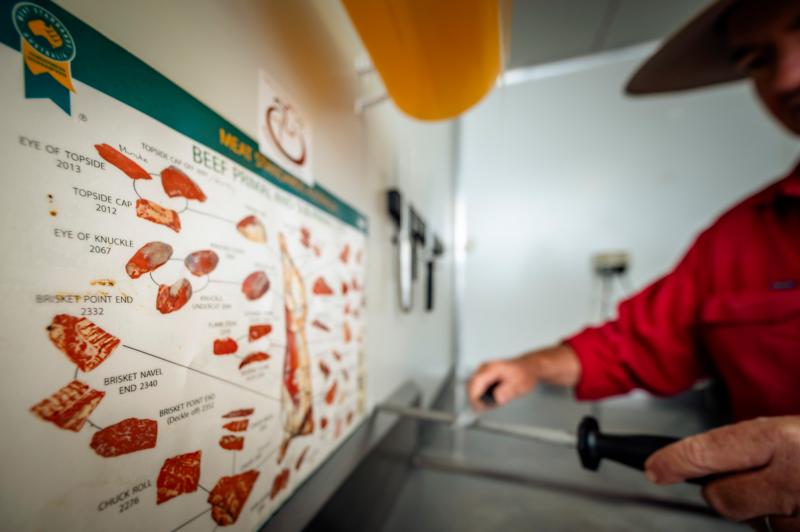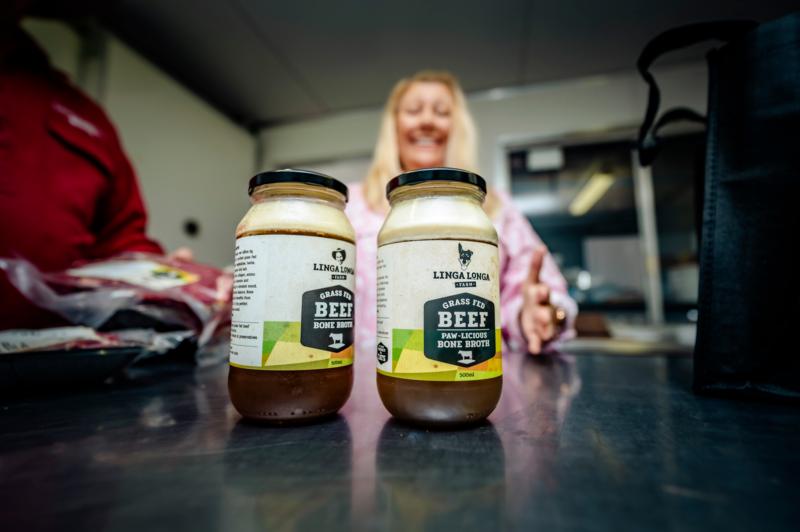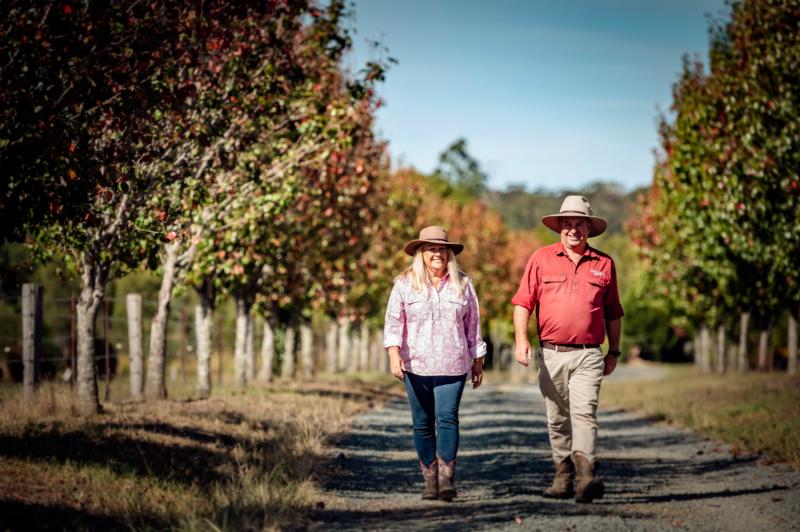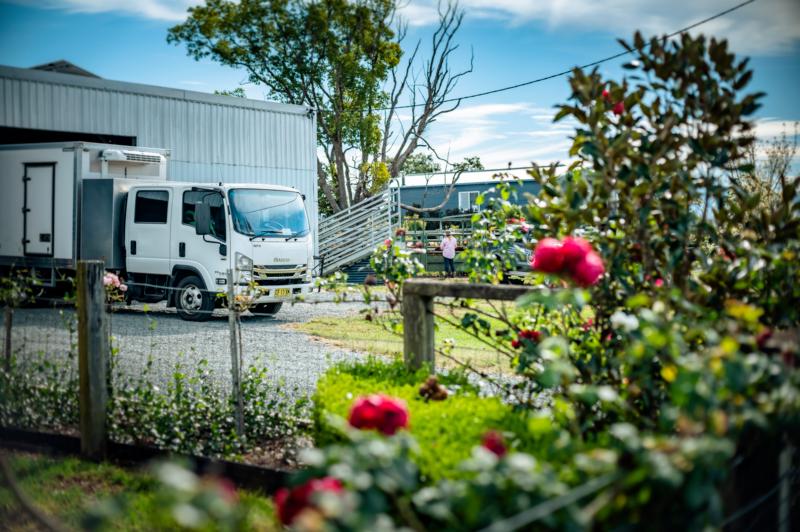Sustainable farming methods help drought preparedness
Greg’s commitment is apparent, even though drought has made life tough. “The drought has been hard, but we haven’t had to bring in any feed,” he says. “Our methods have sustained us.
“There’s a small window to put seed in at the moment. We’ve got high soil percentages and very low moisture content, so we’re relying on the natural grasses to come back and hang on. There’ll be a six-to-eight-week gap over winter where we’ll have no growth because Mother Nature shuts down the plant systems. I need to get as much bulk as I can out of my pasture to carry us through.”
Lauren concedes luck plays a part. “We were seeing it really tough last year. Everything we’d planted through winter had struggled, but we had good rain in October. Those winter pastures came on and we baled about 150 bales of silage and chicory, which we’ve stored – not something we normally do.”
 Grazing cattle purely on farm pastures is a feature used to promote Linga Longa products to customers.
Grazing cattle purely on farm pastures is a feature used to promote Linga Longa products to customers.
The Newells’
buymeat.com.au online sales operation began about 10 years ago as a Facebook marketing exercise. Prior to meeting Lauren, Greg was selling his cattle the “usual” way. With her advertising background, Lauren reckoned social media could be a game changer.
“Advertising on social media was an unknown, but I thought we could spend $10 a week and get a lot of mileage out of it,” she says. “Greg was taking his animals to the cattle yards and one week he’d get $1/kg, another he’d get $1.20. It was like Russian roulette – no control over how much you’d get for the same animal, week to week. Now we have control over what we get.”
Greg says they are now “price givers rather than price takers” and have developed a strong following at the farmers’ markets – especially as consumer demand for authenticity grew. Opening a
farmstay on the property was a big value-add to their marketing. Visitors can interact with the farm in what Lauren terms a “360-degree experience”.
Video source: AirBnb YouTube.
RELATED ARTICLES:
Dairy diversifies into farm tourism
Farmers passionate about soil conservation
City foodie events promote Linga Longa’s padock to plate story
Linga Longa participates in food shows such as
Taste of Sydney, Taste Tuesdays and the
Sydney Royal Easter Show, often under the Meat & Livestock Australia banner. Lauren sends a weekly newsletter to customers to flag any special events.
“The shows have been a great help because we’ve always been advocates for the whole nose-to-tail experience,” she says. “We take part in demonstrations. They might be cooking short ribs. Greg talks about raising the animal, the butcher shows where they are on the beast and the chef cooks.”
 Linga Longa offers a wide range of cuts that were once thrown into the mincer. Cooking demonstrations by chefs at food events enables customers to learn ways to cook these cuts.
Linga Longa offers a wide range of cuts that were once thrown into the mincer. Cooking demonstrations by chefs at food events enables customers to learn ways to cook these cuts.
Preparing for a recent demonstration at Hilton Sydney with celebrity chef Luke Mangan, Lauren says education and marketing go hand-in-hand.
“When we first started selling at the markets, everybody just wanted Scotch fillet or eye fillet,” she says. “I’d cook a minute steak and people would say: ‘My god, this tastes like eye fillet’. Yet it was one of the cheapest cuts on the animal. We were educating them about good-quality, young, grass-fed animals. The cooking shows were starting to promote and cook all those secondary cuts such as brisket and short rib that we would’ve put into mince five years ago.”
Greg says education about meat quality and provenance extends to restaurants.
“If people can be told ‘this is a grass-fed certified organic steak from Linga Longa Farm’, it shows the restaurant cares about the ethics of the food it puts on the table,” he says.
“You want to know where the meat is from, if it’s grain-fed or grass-fed. We do that for cheese and wine. We should do it for steak.” - Greg Newell
RELATED ARTICLES:
Dairy farmers innovate through education
"Fruit growers should focus on quality"
Lauren Newell explains the benefits of bone broth
 Linga Longa’s bone broth is now stocked on the shelves of Harris Farm stores.
Linga Longa’s bone broth is now stocked on the shelves of Harris Farm stores.
How do you make it?
“It’s bones, vegetables, herbs and spices cooked over 48 hours.”
Is it popular?
“I have been selling it at the markets for the past two years. It is growing in popularity due to a growing awareness of its health properties. I recently had it tested for shelf life and can assure people it lasts [up to] five weeks in the fridge. I have just got it into Harris Farm and it has been on the shelves for the past couple of weeks. I’m looking forward to it growing.”
Who buys it?
“Health-conscious consumers. It is rich in nutrients, collagen and calcium, and is believed to help with people suffering gut problems. Women use it for beauty because of the collagen it has. Athletes use it for muscle recovery. I have just started marketing a plain version especially for pets — with our kelpie featured on the label.”
Challenges with making and marketing it?
“It is time-consuming to make. A lot of people make their own, but unless they can be assured the bones are from young, grass-fed animals they’re wasting their time. This year, I’m concentrating on marketing to health food shops. It’s challenging trying to open doors to that market. Taste-testing at the markets is important and I will be doing this over the winter months, as it is perfect for both flu prevention or providing relief if someone has the flu.”
Real farmers are needed at farmers’ markets to answer questions urban dwellers are asking
There are growing concerns some events advertised as farmers’ markets actually have very few stalls from farmers.
Greg reckons consumers can feel burnt. “They want to know the farmer, where he farms, what the differences in those areas mean to the animal,” he says. “They’re taking a lot of interest in climate change and the effects on cattle. They’re asking questions only a farmer could answer.”
 Lauren and Greg have complete traceability of their product and offer the entire paddock to plate experience.
Lauren and Greg have complete traceability of their product and offer the entire paddock to plate experience.
He likes the way the Carriageworks market in Sydney run. “Carriageworks is government-run with a charter. They come onto the farm to look at your operation. None of the others do. Anyone can buy an Akubra hat and say they’re a farmer, but if you don’t know your farmer by name and can’t visit his farm, who the hell are you dealing with?
“There needs to be a licence system, otherwise the wholesalers see it as a grey area to dump a bit of produce. They don’t care about authenticity, just cramming in as many stalls as possible.”
The Newells say it’s not about their profit margin, more the importance of traceability. “It doesn’t hit our sales because customers know we’re genuine farmers as soon as they ask questions,” says Greg.
“The traceability has to be there. The butcher is just buying it from an abattoir and there’s no traceability, no story. Ours is the real deal. It starts in our paddock.”
 Linga Longa truck packed with meat ready for a weekend attending farmers’ markets.
Linga Longa truck packed with meat ready for a weekend attending farmers’ markets.
Lauren adds that Linga Longa cannot compete on price. “They can buy a lot cheaper than we can grow it,” she says. But where the Newells do come out on top is with consistency of produce.
The couple are members of NSW Farmers, and Greg raised the issue of farmers’ market authenticity at the Association’s forum in Wingham, attended by state politicians in the lead-up to the NSW election. “One bloke said he could always tell who the real farmers were, but what about the other customers? They eventually conceded there was a problem.
“To date no-one’s suggested a licensing system or producer number to assist the consumer in finding the genuine product.”
Lauren suggests a name change. “Don’t call it a farmers’ market if it’s not farmers selling genuine farm produce. Call it a food market.”
Greg and Lauren’s farmers’ market tips
1.
Be honest and credible. Welcome people onto your farm and show them around.
2.
We don’t spruik. The produce speaks for itself. And the crowd of people hanging around the display cabinet speaks for itself.
3.
Don’t employ people, do your own selling. The only person who knows about that meat is the person who grew it.